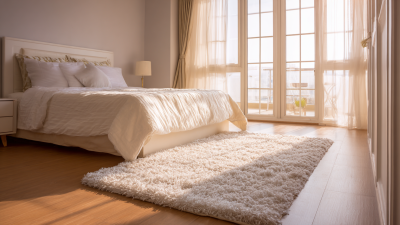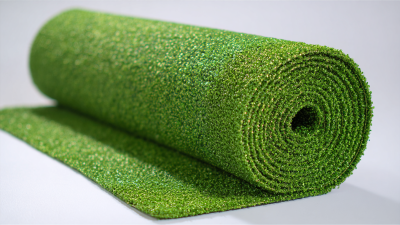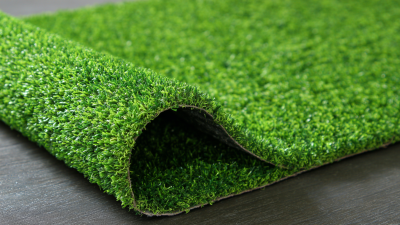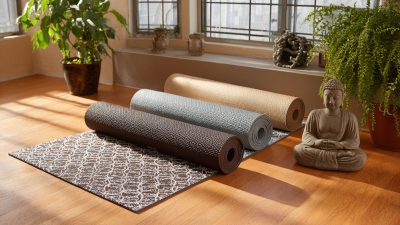Ultimate Checklist for Choosing the Perfect Imitation Grass Matting for Your Outdoor Space
When it comes to enhancing outdoor spaces, the choice of flooring can significantly influence aesthetics and functionality. One increasingly popular option is Imitation Grass Matting, which not only mimics the natural look of grass but also offers practical benefits such as durability and low maintenance. According to industry reports, the global artificial grass market is projected to reach USD 5.4 billion by 2028, with a CAGR of 10.8% from 2021 to 2028. This surge in popularity highlights the growing preference for Imitation Grass Matting in both residential and commercial applications. Whether it's creating a lush play area for children or a charming patio for entertaining, making the right choice in matting is essential for maximizing the benefits of your outdoor space. In this ultimate checklist, we will guide you through the key factors to consider in selecting the perfect Imitation Grass Matting tailored to your needs.

The Importance of Choosing UV-Resistant Imitation Grass Matting for Longevity
When it comes to enhancing your outdoor space, the choice of imitation grass matting is crucial, especially for longevity. One of the key elements to consider is UV resistance. Imitation grass that is not treated for UV protection can quickly fade, degrade, and lose its aesthetic appeal under the harsh sun. Investing in UV-resistant matting ensures that your outdoor area remains vibrant and visually pleasing over the years, allowing you to enjoy a lush look without constant replacements.
Additionally, UV protection plays a vital role in the durability of the material itself. Exposure to sunlight can weaken fibers, causing them to break down faster than expected. By selecting high-quality, UV-resistant imitation grass, you’re not only preserving its color but also extending its useful life, which ultimately serves as a cost-effective solution. Whether you're setting up a children's play area, a pet-friendly zone, or a stylish outdoor lounge, choosing the right matting with UV resistance will guarantee that your investment pays off over time.
Comparative Analysis of Different Types of Synthetic Turf Materials and Their Durability
When it comes to selecting the ideal synthetic turf for your outdoor space, understanding the durability of different materials is crucial. According to a report from the Synthetic Turf Council, polyethylene is one of the most commonly used materials due to its softness and resistance to fading, making it suitable for high-traffic areas such as sports fields and backyards. Its lifespan can vary, but quality products typically last between 15 to 25 years with proper maintenance.
In contrast, polypropylene, known for its affordability, offers a shorter lifespan and is primarily recommended for low-traffic areas. A durability analysis presented by the International Association of Sports Surfaces highlights that while polypropylene can last around 5 to 15 years, it lacks the resilience and UV resistance found in polyethylene. Furthermore, nylon, known as the most durable synthetic turf material, can withstand heavy use and maintain its shape over time, often exceeding a 20-year lifespan. However, its cost can be significantly higher, making it an investment worth considering for those seeking long-term solutions for outdoor spaces.
Durability Comparison of Different Types of Synthetic Turf Materials
This chart displays the expected lifespan (in years) of various types of imitation grass matting options based on material durability. The data aims to help consumers choose the best synthetic turf for their outdoor spaces.
Key Factors to Consider: Pile Height, Density, and Weight for Optimal Comfort
When selecting the perfect imitation grass matting for your outdoor space, three key factors come into play:
pile height, density, and weight.
Pile height significantly impacts the look and feel of your grass matting. A taller pile can create a lush, realistic appearance that resembles a well-manicured lawn, while shorter piles may offer a flatter aesthetic.
Consider the intended use of your space; if it’s for recreational activities, a shorter pile may be more practical to withstand foot traffic.
Density is another crucial factor affecting the durability and comfort of your imitation grass.
Higher density mats provide a richer, more resilient surface that can better endure wear and tear, making them ideal for areas with frequent use.
On the other hand, lower density options can be suitable for decorative purposes or spaces with minimal foot traffic.
Finally, the weight of the matting should not be overlooked, as heavier options tend to stay in place better and resist lifting during windy conditions.
By carefully considering these factors, you can ensure that your chosen grass matting not only enhances your outdoor aesthetics but also meets the functional needs of your space.
Environmental Impact: Understanding the Sustainability of Imitation Grass Options
When considering imitation grass options for your outdoor space, environmental sustainability is an increasingly important factor. According to a report by the Synthetic Turf Council, the adoption of synthetic turf has grown significantly, with over 420 million square feet installed annually in the United States alone. This increase highlights the demand for durable, low-maintenance landscaping solutions. However, the environmental impact of these materials must be scrutinized.
Many imitation grass products are now made from recycled materials, with some brands reporting that up to 60% of their turf fibers come from post-consumer plastics. This recycling process not only reduces landfill waste but also conserves natural resources. Furthermore, an independent study from the International Association of Synthetic Grass Producers indicates that synthetic turf can help conserve approximately 55 gallons of water per square foot compared to natural grass, which is crucial in regions facing water scarcity. As a consumer, selecting environmentally friendly imitation grass options contributes to a more sustainable future while still enjoying the aesthetic benefits of green, lush landscapes.

Maintenance Requirements: How to Choose a Low-Maintenance Grass Matting Solution
When choosing the perfect imitation grass matting for your outdoor space, prioritizing low-maintenance options can simplify your landscaping efforts significantly. Unlike traditional lawn grasses that demand regular watering, mowing, and weeding, modern alternatives such as ground cover plants and meadow lawns offer aesthetic appeal with much less upkeep. These options not only enhance the beauty of your garden but also promote biodiversity and ecological benefits, making them a smart choice for environmentally conscious homeowners.

Additionally, selecting a high-quality imitation grass matting can help you evade common landscape issues like mud and weeds. Implementing a good drainage system and meticulously preparing the ground before installation can alleviate the mess often associated with natural lawns.
Efficient maintenance practices—like occasional cleaning and checking for damage—can ensure your matting remains in gratifying condition over time. Embracing these alternatives can lead to a more enjoyable outdoor experience, allowing you to spend less time working on your garden and more time enjoying it.
Related Posts
-

Discover the Advantages of Choosing the Best Pvc Floor Mats for Your Home
-

The Ultimate Guide to Choosing the Best Plastic Green Grass Mat for Your Business Needs
-

Exploring the Versatility of the Best Plastic Green Grass Mat for Diverse Applications
-

7 Compelling Reasons to Choose Ribbed Outdoor Door Mats for Your Business
-

Innovative Solutions for Optimal Floor Matting in Every Room
-

How to Choose the Best Pvc Floor Mats For Home to Enhance Your Living Space

